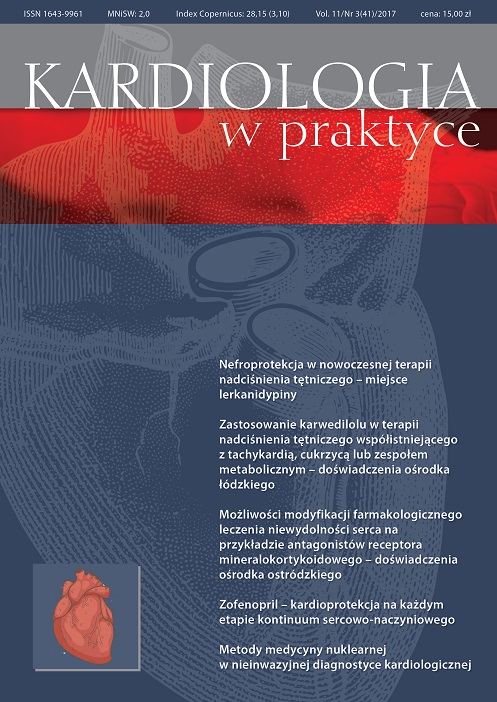Nephroprotection in the modern therapy of hypertension – place of lercanidipine Review article
Main Article Content
Abstract
Treatment of a patient with arterial hypertension and impaired renal function is still a challenge for the clinician. The aim is effective, strict control of blood pressure, which translates into protection against progression of nephropathy and, therefore, can improve the prognosis of this population at risk. The article presents the current location lercanidipine, original drug of the third generation of dihydropyridine calcium channel blockers, in the pharmacotherapy of hypertension and the prevention of subclinical organ damages such as albuminuria and chronic kidney disease.
Downloads
Article Details

This work is licensed under a Creative Commons Attribution-NonCommercial 4.0 International License.
Copyright: © Medical Education sp. z o.o. This is an Open Access article distributed under the terms of the Attribution-NonCommercial 4.0 International (CC BY-NC 4.0). License (https://creativecommons.org/licenses/by-nc/4.0/), allowing third parties to copy and redistribute the material in any medium or format and to remix, transform, and build upon the material, provided the original work is properly cited and states its license.
Address reprint requests to: Medical Education, Marcin Kuźma (marcin.kuzma@mededu.pl)
References
2. Kaplan N.M.: Nadciśnienie tętnicze – aspekty kliniczne. Wydawnictwo Czelej, Lublin 2006.
3. Tykarski A., Narkiewicz K., Gaciong Z. et al.: Zasady postępowania w nadciśnieniu tętniczym – 2015 rok. Wytyczne Polskiego Towarzystwa Nadciśnienia Tętniczego. Nadciśnienie Tętnicze w Praktyce 2015; 1: 1-70.
4. NKF K/DOQI Clinical Practice Guidelines for chronic kidney disease: evaluation, classification and stratification. Am. J. Kidney Dis. 2002; 39(supl. 1): S1-S266.
5. Więcek A., Chudek J.: Nefropatia nadciśnieniowa. W: Pasierski T., Myśliwiec M., Imiela J. (red.): Kardionefrologia. Medical Tribune Polska, Warszawa 2007.
6. Wyrzykowski B.: Nadciśnienie tętnicze. Patofizjologia i terapia. Via Medica, Gdańsk 1999.
7. Culleton B.F., Larson M.G., Wilson P.W. et al.: Cardiovascular disease and mortality in a community-based cohort with mild renal insufficiency. Kidney Int. 1999; 56: 2214-2219.
8. Leoncini G., Viazzi F., Parodi D. et al.: Creatinine clearance and signs on end-organ damage in primary hypertension. J. Hum. Hypertens. 2004; 18: 511-516.
9. Campese V.M., Mitra N., Sandee D.: Hypertension in renal parenchymal disease: why is it so resistant to treatment? Kidney Int. 2006; 69(9): 967-973.
10. Coresh J., Wei G.L., McQuillan G. et al.: Prevalence of high blood pressure and elevated serum creatine level in the Unites States: Findings from the third National Health and Nutrition Examination Survey. Arch. Intern. Med. 2001; 161: 1207-1216.
11. Sarafidis P.A., Li S., Chen S.C. et al.: Hypertension awareness, treatment, and control in chronic kidney disease. Am. J. Med. 2008; 121: 332-340.
12. Wright J.T., Bakris G., Greene T. et al.: Effect of blood pressure lowering and antihypertensive drug class on progression of hypertensive kidney disease. Results from the AASK trial. JAMA 2002; 288: 2421-2431.
13. Ruggenenti P., Perna A., Loriga G. et al.: Blood-pressure control for renoprotection in patients with non-diabetic chronic renal disease (REIN-2): multicentre, randomised controlled trial. Lancet 2005; 365: 939-946.
14. Leoncini G., Viazzi F., Rosei E.A. et al.: Chronic kidney disease in hypertension under specialist care: the I-DEMAND study. J. Hypertens. 2010; 28(1): 156-162.
15. Zdrojewski Ł., Król E., Rutkowski B. et al.: Chronic kidney disease in Polish elderly population aged 75+: results of the WOBASZ Senior Survey. Int. Urol. Nephrol. 2017; 49(4): 669-676.
16. Załuska W., Klinger M., Kusztal M. et al.: Rekomendacje Grupy Roboczej Polskiego Towarzystwa Nefrologicznego dotyczące kryteriów leczenia dializami pacjentów z powodu schyłkowej niewydolności nerek. Nefrol. Dial. Pol. 2015; 19: 6-11.
17. Król E., Rutkowski B.: Przewlekła choroba nerek – klasyfikacja, epidemiologia i diagnostyka. Forum Nefrologiczne 2008; 1(1): 1-6.
18. Foley R.N., Parfrey P.S., Sarnak M.J.: Clinical epidemiology of cardiovascular disease in chronic renal disease. Am. J. Kidney Dis. 1998; 32: S112-S119.
19. Kostka-Jeziorny K., Tykarski A., Dzida G. et al.: Lerkanidipina w leczeniu nadciśnienia tętniczego i jego powikłań sercowo-naczyniowych. Nadciśnienie Tętnicze 2012; 4: 216-223.
20. Sabbatini M., Leonardi A., Testa R. et al.: Effects of dihydropyridine-type Ca antagonists on the renal arterial tree in spontaneously hypertensive rats. J. Cardiovasc. Pharmacol. 2002; 39: 39-48.
21. Della Vestra M., Pozza G., Mosca A. et al.: Effect of lercanidipine compared with ramipril on albumin excretion rate in hypertensive type 2 diabetic patients with microalbuminuria: DIAL Study (diabete, ipertensione, albuminuria, lercanidipina). Diabetes Nutr. Metab. 2004; 17: 259-266.
22. Robles N.R., Ocon J., Gomez C.F. et al.: Lercanidipine in patients with chronic renal failure: the ZAFRA study. Ren. Fail. 2005; 27: 73-80.
23. Robles N.R., Romero B., de Vinuesa E.G. et al.: Treatment of proteinuria with lercanidipine associated with renin-angiotensin axis-blocking drugs. Ren. Fail. 2010; 32; 192-197.
24. Robles N.R., Calvo C., Sobrino C. et al.: Lercanidipine valuable effect on urine protein losses: the RED LEVEL study. Curr. Med. Res. Opin. 2016; 32(supl. 2): 29-34.

